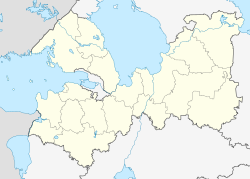Staraya Ladoga
Staraya Ladoga (Roushie: Ста́рая Ла́дога), Finnish: Vanha Laatokka or the Aldeigjuborg o Norse sagas, is a veelage (selo) in the Volkhovsky Destrict o Leningrad Oblast, Roushie, locatit on the Volkhov River near Lake Ladoga, 8 km north o the toun o Volkhov. The veelage uised tae be a prosperous tradin ootpost in the 8t an 9t centuries. A multi-ethnic dounset, it wis dominatit bi Scandinavies who wur cried bi the name o Rus an for that raison is sometimes cried the first caipital o Roushie.
Staraya Ladoga Старая Ладога | |
|---|---|
| Coordinates: 59°59′N 32°18′E / 59.983°N 32.300°ECoordinates: 59°59′N 32°18′E / 59.983°N 32.300°E | |
| Kintra | Roushie |
| Federal subject | Leningrad Oblast |
| Foondit | 753 |
| Time zone | UTC+3 (Moscow Time |
| Postal code(s)[2] | 187412 |
| OKTMO ID | 41609462101 |
Oreegin an name eedit
Dendrochronology suggests that Ladoga wis foondit in 753. Till 950, it wis ane o the maist important tradin ports o Eastren Europe. Merchant vessels sailed frae the Baltic Sea through Ladoga tae Veliky Novgorod an then tae Constantinople or the Caspian Sea. This route is ken as the Trade Route frae the Varangians tae the Greeks. An alternative wey led doun the Volga River alang the Volga trade route tae the Khazar caipital o Atil, an then tae the soothren shores o the Caspian Sea, aw the wey tae Baghdad. Tellingly, the auldest Arabie Middle Age coin in Europe wis unearthed in Ladoga.
Auld (staraya means "auld") Ladoga's inhabitants wur Norsemen, Finns, an Slavs, hence different names for the ceety. The oreeginal Finnish name, Alode-joki (i.e., "lowland river"), wis rendered as "Aldeigja" in Norse leid an as "Ladoga" (Ладога) in Auld East Slavic.
Ladoga unner Rurik an Rurikids eedit
Accordin tae the Hypatian Codex, the legendary Varangian leader Rurik arrivit at Ladoga in 862 an made it his caipital. Rurik's successors later muivit tae Novgorod an then tae Kiev, thus layin foondations for the pouerful state o Kievan Rus. Thare are several huge kurgans, or ryal funerary barraes, at the ootskirts o Ladoga. Ane o them is said tae be Rurik's grave, an anither ane—that o his successor Oleg. The Heimskringla an ither Norse sources mention that in the late 990s Eiríkr Hákonarson o Norawa raidit the coast an set the toun ablaze. Ladoga wis the maist important tradin center in Eastren Europe frae aboot 800 tae 900 CE, an it is estimatit that atween 90 tae 95% o aw Arab dirhams foond in Swaden passed through Ladoga.
Ladoga's next mention in chronicles is datit tae 1019, when Ingigerd o Swaden marriet Yaroslav o Novgorod. Unner the terms o their marriage dounset, Yaroslav cedit Ladoga tae his wife, who appointit her faither's cousin, the Swadish earl Ragnvald Ulfsson, tae rule the toun. This information is confirmit bi sagas an airchaeological evidence, which suggests that Ladoga gradually evolvit intae a primarily Varangian dounset. At least twa Swadish kings spent their youths in Ladoga, king Stenkil an Inge I, an possibly king Anund Gårdske an aw.
In the 12t an 13t centuries, Ladoga functioned as a trade ootpost o the pouerful Novgorod Republic. Later its trade significance declinit an maist o the population engagit in fishin in 15t century.[3] Efter new fortresses such as Oreshek an Korela wur constructit in 14t century further tae the wast o Ladoga the toun's militar significance decreased an aw. Ladoga belangit tae the Vodskaya pyatina o the republic an contained 84 hamesteids in 15t century; maist o the laund belangit tae the kirk.[3] The Novgorodians built there a citadel wi five touers an several kirks. The fortress wis rebuilt at the turn o the 15t an 16t centuries, while the mid-12t-century kirks o St. George an o Mary's Assumption staund in aw their oreeginal glory. Inside St. George's, some magnificent 12t-century frescoes are still visible.
The reconstruction o pairt Staraya Ladoga's fortress is wis completit in 2010.[4]
Sichts an landmarks eedit
In 1703, Peter the Great foondit the toun o Novaya Ladoga (New Ladoga) closer tae the bank o Lake Ladoga. The auncient fortress thenceforth declined an came tae be kent as Auld Ladoga, in order tae distinguish it frae the new toun.
The hert o Staraya Ladoga is an auld fortress whaur the Yelena River flows intae the Volkhov River. In earlier times, it wis a strategic steid acause it wis the anerlie possible harbour for sea-vessels that coud no navigate through the Volkhov River. Apairt frae the kirks mentioned abuin, there is a mid-12t century kirk o St. Climent, which staunds in ruins. Thare is a monastery an aw, dedicatit tae St. Nicholas an constructit mainly in the 17t century.
Gallery eedit
-
View o Novaya Ladoga in 1911.
-
St. George's Kirk in the Ladoga Fortress.
-
8t tae 10t century Viking burial munds alang the Volkhov River near Staraya Ladoga.
References eedit
- ↑ "Об исчислении времени". Официальный интернет-портал правовой информации (in Roushie). 3 Juin 2011. Retrieved 19 Januar 2019.CS1 maint: unrecognised leid (link)
- ↑ Почта России. Информационно-вычислительный центр ОАСУ РПО. (Russian Post). Поиск объектов почтовой связи (Postal Objects Search) (in Roushie)
- ↑ a b Bernadsky, Viktor Nikolayevich (1961). Новгород и новгородская земля в XV веке (Novgorod and the Novgorod Land in XV century). Leningrad (Saint Petersburg): published by the USSR Academy of Sciences. pp. 130–131.
- ↑ "In Staraya Ladoga in 2010 will recreate Strelochnaya tower of a fortress Russian:В Старой Ладоге в 2010 году воссоздадут Стрелочную башню крепости". Leningrad Oblast (in Roushien). karpovka.net. 22 August 2009. Retrieved 24 August 2009. freemit airtin in
|publisher=(help)
Freemit airtins eedit
- History o Auld Ladoga Archived 2005-04-06 at the Wayback Machine
- Aboot Auld Ladoga Archived 2009-10-24 at the Wayback Machine
- Detailed info on the fortress
- (in Roushie) Auld Ladoga Museum Archived 2010-04-22 at the Wayback Machine




